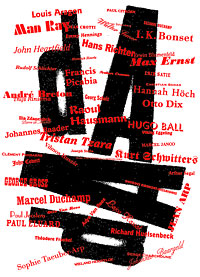Dada
dal 3/10/2005 al 9/1/2006
Segnalato da
Hans Arp
Sophie Taeuber-Arp
Hannah Hoch
Raoul Hausmann
George Grosz
John Heartfield
Kurt Schwitters
Max Ernst
Francis Picabia
Man Ray
Marcel Duchamp
Louis Aragon
Johannes Baader
Hugo Ball
Andre Breton
Jean Crotti
Paul Eluard
I.K. Bonset
Marcel Janco
Clement Pansaers
Tristan Tzara
Hans Richter
3/10/2005
Dada
Centre Pompidou, Paris
A re-reading of one of the major international movements of the first half of the 20th century. More than 1,000 works by 50 artists from prestigious public and private collections. The exhibition presents a dynamic panorama of paintings, sculptures, photographs, collages, photomontages and graphic documents, as well as sound recordings and films. The exhibition has been organized with the National Gallery of Art in Washington D.C. and in collaboration with the Museum of Modern Art in New York.

A re-reading of one of the major international movements of the first half of the 20th century
The Centre Pompidou, Musée national d’art moderne proposes a re-reading of Dada, one of the major international movements of the first half of the 20th century. Dada, the irreverent “anti-art†movement will enjoy an unprecedented scope in these exhibition with more than 1,000 works by 50 artists from prestigious public and private collections will be on view. The Centre Pompidou will exhibit nearly all of its Dada collection, one of richest in the world. The Museum of Modern Art in New York will also lend some 100 works, to the Dada exhibition. After its unique European debut, Dada will be shown in a modified version at the National Gallery of Art in Washington D.C. (19 February to 14 May 2006), and then in New York at MoMA (18 June to 11 September 2006). The exhibition has been organized with the National Gallery of Art in Washington D.C. and in collaboration with the Museum of Modern Art in New York.
Born during the First World War, the Dada movement expressed a raging contempt for existing values. In its wake, the industrial object was considered as a work of art; performances, sound poetry and the practice of collage, among others, were soon determining elements in the history of art in the 20th century.
The 1910s and the early 1920s saw the advent of the illustrated press, radio, assembly line work and cinema as commercial phenomena. Dada seized the new media and the “culture of the machine,†and succinctly subjected them to biting criticism. The participants in Dada expressed, through
references to modernity, a voracious interrogation of modernity itself.
The Dada exhibition presents a dynamic panorama of paintings, sculptures, photographs, collages, photomontages and graphic documents, as well as sound recordings and films. This rich ensemble of works puts the entire Dada period on parade – from 1916, the date of the foundation of the impertinent Cabaret Voltaire in Zurich, to 1924, when the majority
Exhibition of Dadaist groups had left the scene.
The exhibition features many figures of Modernism who took part in the multiple expressions of Dada. Here are specific idioms of the movement that issued from Zurich, Berlin, Hanover, Cologne, Paris and New York, as well as in the Netherlands, Belgium, Italy and Japan.
The artists presented include icons of Modernism, including Hans (Jean) Arp, Sophie Taeuber-Arp, Hannah Höch, Raoul Hausmann, George Grosz, John Heartfield, Kurt Schwitters, Max Ernst, Francis Picabia, Man Ray, Marcel Duchamp, Louis Aragon, Johannes Baader, Hugo Ball, André Breton, Jean Crotti, Paul Eluard, I.K. Bonset, Marcel Janco, Clément Pansaers, Tristan Tzara, and Hans Richter.
At the crossroads of multiple influences, the Dada exhibition shows the creative explosion of the first half of the 20th century – one that gives as much significance to words as to images. Thus, a very significant number of books, reviews, photographs and manuscripts are brought together thanks to the exceptional support of the Bibliothèque Littéraire Jacques Doucet and the Bibliothèque Paul Destribats.
The exhibition’s design reserves a noteworthy place for seminal Dada films, among them Viking Eggeling’s Diagonal Symphony, 1921; Paul Strand/Charles Sheeler’s Manhatta, 1921; Hans Richter’s Rhythmus 21, 1921, Rhythmus 23, 1923-1925 Filmstudie, 1926, and the Vormittagsspuk, 1927-1928; René Clair’s Entr’acte, 1924; and Marcel Duchamp’s Anémic Cinema, 1925.
In co-production with Ircam (Institut de Recherche et de Coordination Acoustique/Musique), composer Gilles Grand was commissioned to create
a contemporary interpretation of the simultaneous poem “L’Amiral
cherche une maison à louer†(“The Admiral seeks a house to rentâ€) from
1916. This installation, placed at the beginning of the exhibition, uses
the revolutionary broadcast sound technology, Wave Field Synthesis (WFS),
invented by the University of Delft, The Netherlands and developped
by sonic emotion and Ircam.
In conjunction with the exhibition
“ZAPPING DADA†evening
Sunday 8 January 2006, from 6 to 11 PM,
Grande salle, level –1
Special price: 6 euros
« Zapping Dada » will include many artists and art historians who will evoke Dada in an original program, whose common denominator will be the brevity of each presentation.
Vernissage: 04 october 2005
Centre Pompidou
Place Georges Pompidou - Paris
Hours: exhibition open every day except Tuesday, from 11 AM to 9 PM. Thursday evenings until 11 PM.



